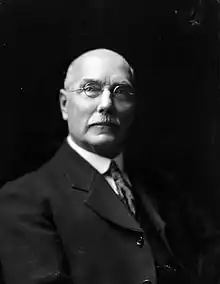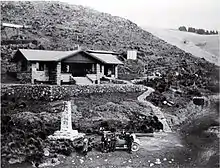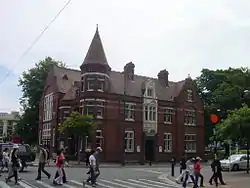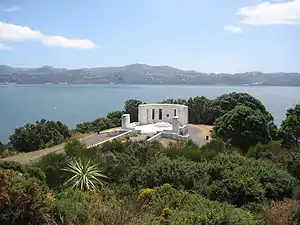Samuel Hurst Seager
Samuel Hurst Seager CBE (26 June 1855 – 5 October 1933) was a notable New Zealand builder, draftsman, architect and town planner. He was born in London, England, in 1855, and as a boy emigrated to Christchurch, New Zealand, with his parents in 1870.[1]
Samuel Hurst Seager | |
|---|---|
 Seager in 1926 | |
| Born | 26 June 1855 London, England |
| Died | 5 October 1933 (aged 78) Sydney, New South Wales, Australia |
| Nationality | New Zealander |
| Occupation | Architect |
| Buildings | Daresbury Christchurch Municipal Chambers |
He was one of the pioneers of the New Zealand bungalow.[1][2] He purchased land on Clifton Hill in Sumner and designed and established a garden suburb with eight bungalows which were sold in 1914.[3] Seager resided at No.1 The Spur for eight years from 1902.
Two of his notable buildings are Daresbury at 67 Fendalton Road and the Christchurch Municipal Chambers.[4]
In the 1926 King's Birthday Honours, he was appointed a Commander of the Order of the British Empire.[5]
Gallery of his work
_050.JPG.webp)

Sign of the Packhorse on the summit road (Christchurch) 
Sign of the Bellbird on the summit road (Christchurch) 
Sign of the Kiwi on the summit road (Christchurch) 


Cranmer Bridge Club, Christchurch
References
| Wikimedia Commons has media related to Samuel Hurst Seager. |
- Lochhead, Ian J. "Samuel Hurst Seager". Dictionary of New Zealand Biography. Ministry for Culture and Heritage. Retrieved 7 September 2016.
- Barnes, Anthony (2014). "Translation in the Transition: Examining Innovations in the Design of Auckland's Transitional Houses" (PDF). unitec.ac.nz. Auckland, New Zealand: SAHANZ and Unitec ePress; and Gold Coast, Queensland: SAHANZ.
- The Spur, Sumner: the property of S. Hurst Seager. Christchurch: Christchurch Press Printers. 1914 – via http://christchurchcitylibraries.com/DigitalCollection/Publications/1910s/TheSpurAuction/TheSpurAuction.pdf.
{{cite book}}: External link in|via= - "Municipal Chambers". Retrieved 4 September 2016.
- "No. 33179". The London Gazette (Supplement). 3 July 1926. p. 4414.
This article is issued from Wikipedia. The text is licensed under Creative Commons - Attribution - Sharealike. Additional terms may apply for the media files.